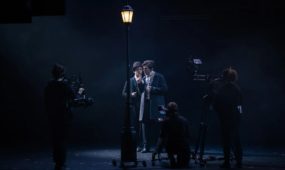Experimenting with the future of filmmaking
Arts
RICHARD Harris knew he had to take drastic action when he took over the South Australian Film Corporation (SAFC) seven years ago. It had been over a decade since South Australia had produced any new filmmaking talent, and wading through mountains of scripts or enduring rounds of script development was not going to cut it.

Sign up to receive notifications about new stories in this category.
Thank you for subscribing to story notifications.
“It had been ten years since we'd invested in a new writer, director or producer from South Australia in a long form project,” recalls Harris. “We had done a lot of small initiatives, done some documentary, short films and other things which hadn't kicked anyone through to making (feature films).”
Choosing the talent was a big difference we've had compared to others, where generally it is based on the script.
Looking around the world at programs that assisted emerging filmmakers he found a series of script development and filmmaking courses but none that promised a production outcome.
He decided to turn the whole filmmaking model on its head with a an intense creative program that guaranteed production investment upfront, without a script.
Called FilmLab, he took a risk with taxpayers’ dollars and gave recipients a guaranteed production budget of $350,000. While this placed the filmmakers under the constraints of creating a low budget feature, it allowed the SAFC to invest in seven emerging directors.
“We put a strong director's slant on the Lab compared to perhaps other schemes,” says Harris. “Choosing the talent was a big difference we've had compared to others, where generally it is based on the script.”
Feature film developer and producer Stephen Cleary was brought in to find two groups to go through FilmLab. The first group began the program in 2009 followed by a second group in 2010.
Cleary delivered a creative bootcamp that saw filmmakers sing, skip and make craft models of their film. The focus was to test ideas, concepts and push filmmakers out of their comfort zone even before the writing process began.
“It was a very creatively driven exercise from the start,” acknowledges Harris. “I had very realistic expectations of saying ‘if a couple of these films get in to major festivals we'll be ecstatic’.”
What followed were seven low budget feature films that challenged the conventions of filmmaking, attracted some of Australia’s finest actors and have gone on to win national and international awards.
The first film to be completed was the documentary Shut Up Little Man! that premiered at the Sundance Film Festival in 2011 and picked up distribution deals in the United States, Canada and Australia.
Then this year 52 Tuesdays also premiered at Sundance and director Sophie Hyde won the World Dramatic Directing Award. Next, at Berlin Film Festival, she won the Crystal Bear for Best Film in the Generation 14Plus program that awards children and youth focused films.
This year also saw The Infinite Man make its world premiere at the South by SouthWest Film Festival. The Indiewire Critics Network Poll of all SXSW films awarded the South Australian film Best Screenplay, Best First Feature and Runner Up Best Ensemble Cast.
Other films in the program Touch and One Eyed Girl will launch in Australia later this year. Dead Speak Back and Inner Demon are currently on the international festival circuit.
“We could have held a party and no one came,” says Harris. “If there was mediocre talent here the whole thing could just look really poor or it could just have not had the impact that it's had so we've been really blessed.”
Jump to next article



